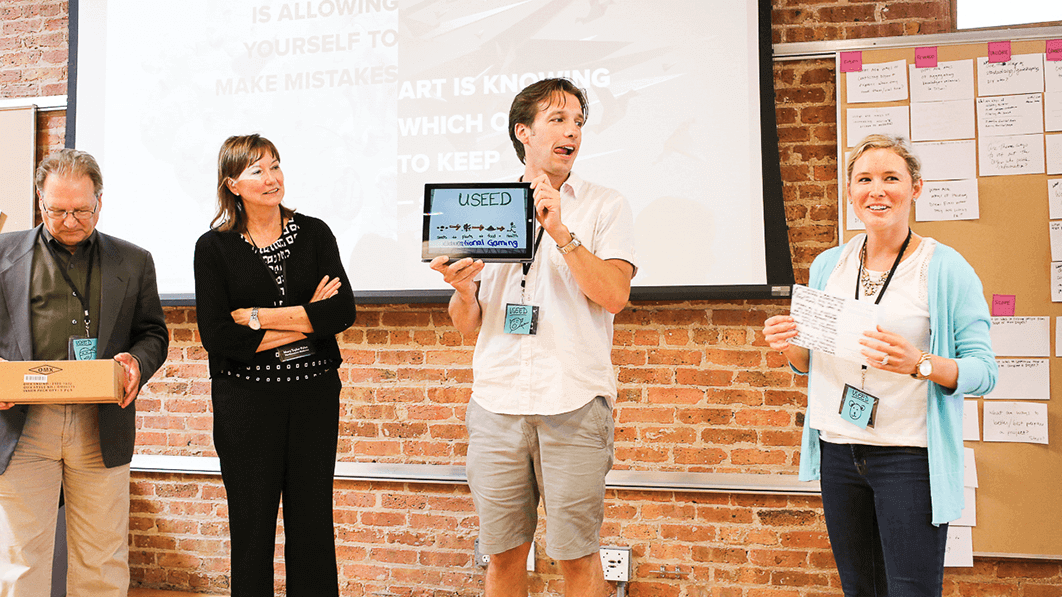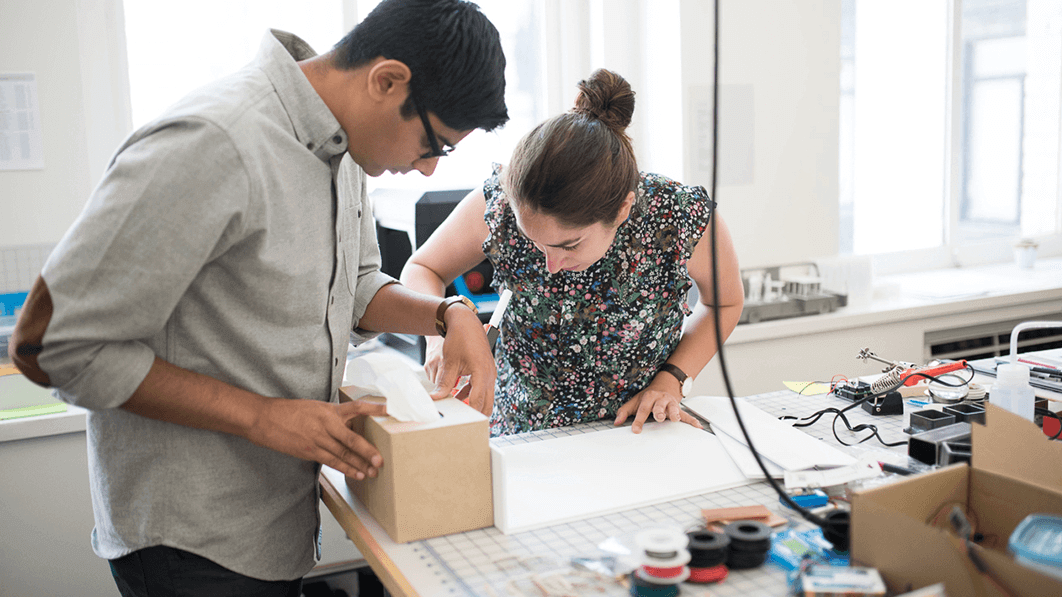4 Ways to Cultivate Innovative Work
Every leader wants their organization to be more effective at creating new value. Here are four behaviors that will unlock that capability for you.
May 12, 2016
With the business environment at one of its most dynamic periods in history, it can be a struggle to get people to work outside of their well-defined roles and comfort zones.
And the management practices of the last fifty years aren’t much help. Consider scorecards that are set and reviewed on an annual basis. They seem woefully disconnected from the speed with which your market is changing and your people may need to respond. It’s why Design Thinking and Lean Startup have captured an unfair share of management attention.What can you do?
As a leader of a small team or a large organization, you are in a great position to cultivate innovative behavior.
First, you should be familiar with the principles and methods used to do innovative work: Deeply understanding your customer’s experience; Framing a problem creatively; Prototyping and testing ideas quickly.
Next, you need to enable others in your organization to work in more innovative ways. You are in a position to advocate for interesting work. You can create the conditions for more innovative behaviors.Your mindset, behavior and expectations can be a huge catalyst for change.
Leadership in the disruption economy
In the current economy of disruption, nothing is certain. Little is provable. It is an entrepreneurial environment, not an operational one.To lead in the disruption economy you need to foster curiosity, engagement, and experimentation. These are the behaviors that end up discovering new sources of value. They inspire action in the face of uncertainty. They pursue and engage the unfamiliar to figure it out.
Consider these four ways to lead and cultivate innovative work in your organization.

1. Demonstrate curiosity and engage in conversations about new possibilities
The leadership currency of the last 100 years has been industry knowledge, experience and certainty. It is one reason that leaders dismiss new, innovative businesses or consumer behaviors. Bitcoin? Snapchat? “Bah! Passing fads…”Instead of being quick to dismiss or ignore, engage with your colleagues in conversations about new ideas. “What is that about?” “Who is using it?” “Why are people fascinated with it?” “What am I missing?” “Where could this go?”
This curiosity about new ideas opens the organization to possibilities. It improves people’s ability to sense new opportunities and changing dynamics.
Many organizations have started Foresight practices that regularly explore and report on emerging trends, new technologies, and consumer behaviors.
But you do not need to set up another function to start!
Begin by demonstrating curiosity and creating space in the organization for conversations. You could host lunch once a month where everyone is invited to share an emerging trend they think could be relevant to the organization.

2. Encourage staff to get out of the building to engage in new experiences
It is easy to fall into the routine of a modern job. A schedule full of meetings, getting through email at your desk and a few business trips to suppliers or customers. Even if you work from home, the work day becomes routine.When there’s so much to do, who has time to explore?That, my friend, is a recipe for getting blindsided! Or becoming irrelevant.
Instead, encourage your colleagues to get out and experience new products and services. It is amazing how many new products or services we talk about but never try. Trying them is a critical learning experience. It shapes your understanding of a changing world.I still remember seeing Facebook for the first time in 2008. And Twitter. Then Uber in 2010. Each was so easy to dismiss! Now they shape the business and social landscapes.
There are countless many new products and services being launched every year. You and your team should be engaging with them. Trying them out for yourselves.
The goal isn’t to adopt every new technology or product. Nor is it to pick the winners from the losers.
You experience new things to advance your understanding of what is possible so you can shape innovative solutions in your own industry.

3. Demo or Die!
How long does your team talk about an idea before making the first version happen? If you’re like most organizations, you talk about ideas all the time.“Maybe we could…”
But you rarely pursue the ideas. Maybe you’re waiting for someone to approve of or encourage your work. Maybe you’re not certain it’s a good idea. Maybe you don’t have everything figured out.
It’s time to start making ideas happen. The MIT Media Lab built is world renowned reputation on the notion of “Demo or die.”The professors and students at the Media Lab pursue cutting edge research. But none of the thousands of visitors each year see or know about a particular research project unless the researcher creates a tangible demonstration of it — a demo.
Tours of the Media Lab are now legendary. It’s where people go to see and experience possibilities of the future.You should make “demo or die” the mantra on your team as well. No matter your industry, you need to develop the ability to create and try ideas quickly.
You don’t have to be a designer or engineer to make your ideas come to life. In all of our client workshops, everyone (from sales reps to the CIO) prototypes their ideas. They use paper, foam core and other relevant materials to make their ideas tangible. They use props and repurpose existing things to show how their idea could work.
Demos and prototypes create new kinds of conversations. They build momentum for an initiative. And they always uncover new insights about what is possible and how new value can be created.
This simple principle could revolutionize decision-making in organizations today. Stop pitching ideas and proposals for new initiatives with a Powerpoint deck. It’s time to flip that on its head and start demonstrating ideas to each other.

4. Shape ideas for value, iteratively, over time
We all have a terrible proclivity to want to judge an idea as good or bad. Yet “an idea” is only a small part of any new, innovative solution. An innovative solution requires hundreds of ideas.Ideas are not fully formed when we first think of them. As you take an idea and sketch it or make a prototype, all sorts of issues begin to emerge. “Oh, it probably has to be smaller.” “It doesn’t work in this situation.” “How will people carry it?”
While ideas are important, the real value is created as you shape ideas over time into a solution.What does this mean for leadership behavior?
Start by assessing how you evaluate ideas in your organization. Do you evaluate ideas as if they are good or bad? Is your mindset that you will pick the good ideas over the bad ones?
These behaviors kill promising initiatives long before they have a chance of developing.
Worst of all, do you evaluate and question the value of a project by noting all the reasons it won’t work? There are many reasons why any initiative “won’t work.” That’s what will be worked on during the project.
Instead, start cultivating your team’s ability to iterate and shape ideas for value. Encourage forward momentum rather than questioning value. Evaluate the speed with which the team turns around a new version and how much more value is created with that iteration.
Each iteration should prove more promising. You should feel momentum accelerating. It should not feel like you are evaluating new ideas at the same level each time. It should feel as if the solution is getting stronger and more viable.
This doesn’t mean you can avoid making tough choices and killing projects. But you won’t be stopping them because you thought they were a bad idea. You’ll stop them because they aren’t the best option in the portfolio of solutions that you are shaping.
Work on new leadership behaviors today
None of these leadership behaviors are revolutionary. But they are different than the management principles that have ruled business for the past 50 years. It’s no longer about having all the answers and being the most experienced.
Can you be more curious and engage in speculative conversations? Do you believe a lot can be learned outside the walls of your organization? Will you invest in your organization’s ability to prototype ideas quickly? Can you get your teams to be really good at shaping ideas for more and more value?Pick one of these and work on it this week. Or share this article with your colleagues and decide which behavior is a priority to cultivate.
I guarantee you will see a quick impact.



